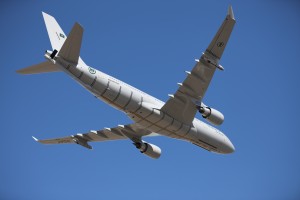7/3/12: by Robbin Laird
During the U.S. tanker competition, one journalist made the comment that this was simply a competition about a gas station in the sky. This comment revealed only partial understanding of what a modern air tanker can bring to operations.
The A330 MRTT tanker as a fleet provides the possibility for a network of flying air support systems engaged for a long time in an operational setting.
Much depends on how these assets become configured.

With the fuel carried in the wings, the large deck of the A330 can be used to host a variety of air support capabilities: routers, sensors, communication nodes, etc.
Such a configuration along with the fuel re-supply capabilities of the A330 tanker makes this a flying air operational support asset.
If the model selected is similar to the model downselected initially by the USAF, it is refuelable in flight.
With the space available in the aircraft – again because of the fact that the fuel for refueling is carried in the wings – a crew rest area can be provided.
This means that the air tankers can stay aloft for a significant period of time as the refuelers are themselves refueled.
This in turn means that the refueling aircraft as a fleet can have a strategic impact.
Once the planes are airborne and they have access to refuelers for their own operational autonomy, the fleet can tank a variety of national or coalition partners operating from dispersed or diverse airfields.
And the discretion possible airborne can allow nations to tank a variety of coalition partners, some of whom might not be favorite candidates if seen on the ground.
Nowhere is this more important than in areas with very constricted geography.
And the GCC states operate with very little strategic depth nation by nation.
SLD: A key reality for the UAE is geography. They live in a congested geographical space with no strategic depth.
How does this shape their perspective?
Gervais: It is really a key dimension.
They have very little response time for any attack which would be mounted against them. They have as you say no strategic depth.
This means that they have to prepare effectively in order to have an integrated deterrent.
https://sldinfo.com/evolving-uae-perspectives-on-gulf-security/
But by deploying a fleet of A330 tankers, the GCC states can some strategic depth airborne. By having similar and shared assets and training, they can support one another’s fighters and other air assets and provide the capability for a nation’s planes to operate off of airfields which are not their own.
This provides a significant enhancement of strategic depth of the sort required for deterrence by the GCC states of a state like Iran, which does have much greater strategic depth.
Notably, both Saudi Arabia and the UAE are buying similar A330 tankers and at numbers which would allow them to pool assets.
The acquisition of the aircraft and its use could well lead to the sort of concepts of operations suggested here.


